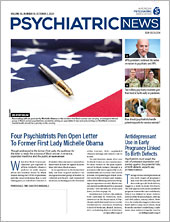The COVID-19 pandemic is a disaster like few Americans have experienced before.
“This isn’t a tornado, it isn’t a hurricane, it isn’t an episode of mass violence,” said Joshua Morganstein, M.D., chair of the APA Committee on Psychiatric Dimensions of Disasters. “All of those are distressing and troubling things, but this pandemic is unique, and people are experiencing it in incredibly different ways.”
Many people are feeling distressed, unsafe, and uncertain, making it difficult to plan for the future, Morganstein said. Even a few months into the pandemic, the mental health impacts were already apparent.
In late June, U.S. adults reported worsening mental health associated with the COVID-19 pandemic, according to a study published in the Morbidity and Mortality Weekly Report. Young adults, individuals who identified as Black and/or Hispanic, essential workers, and unpaid adult caregivers reported disproportionately worse mental health outcomes.
“Addressing mental health disparities and preparing support systems to mitigate mental health consequences as the pandemic evolves will continue to be needed urgently,” wrote lead author Mark Czeisler and colleagues. Czeisler is an organizer with the COVID-19 Outbreak Public Evaluation (COPE) Initiative, a collaboration between Monash University and Austin Health in Australia, as well as Brigham and Women’s Hospital and Harvard Medical School in Boston. For the study, The COPE Initiative partnered with the Social and Behavioral Health Team of the Community Interventions and Critical Populations Task Force of the CDC’s COVID-19 Response Team.
The researchers conducted web-based surveys of 5,470 adults aged 18 and older across the United States from June 24 to 30. The surveys used the Patient Health Questionnaire-4 to assess whether respondents had symptoms of anxiety and/or depressive disorders and the Impact of Event Scale to assess trauma- and stressor-related disorder symptoms. Respondents were also asked if they had started or increased substance use to cope with stress or emotions related to the pandemic and if they had seriously considered suicide in the past 30 days.
Overall, 40.9% of respondents reported symptoms of at least one adverse mental health condition, including anxiety, depression, and increased use of substances to cope with stress related to the pandemic. About a quarter of the respondents reported symptoms of trauma- and stressor-related disorders (including posttraumatic stress disorder, acute stress disorder, and adjustment disorders) related to the pandemic.
The percentage of respondents who reported having seriously considered suicide in the past 30 days was significantly higher among those aged 18 to 24 years, members of racial/ethnic minority groups, self-reported unpaid adult caregivers, and essential workers.
“Community-level intervention and prevention efforts, including health communication strategies, designed to reach these groups could help address various mental health conditions associated with the COVID-19 pandemic,” the authors wrote.
Compared with results of similar surveys conducted in 2019, the prevalence of anxiety disorder symptoms was three times higher, while the prevalence of depressive disorder was four times higher.
Even as the pandemic continues, Morganstein pointed out that disasters are colliding. The world is dealing with financial crises and social unrest, he said, and people who had less access to resources before the pandemic will likely experience more stress as all the impacts of these disasters accumulate.
One of the challenges of the CDC’s study is that it did not assess what factors are driving the worsening mental health among the populations that are especially impacted. “The only way for us to have a sense of what’s happening in our society is to gather the data to understand the exposures and risks,” he said. “That kind of information will aid in community responses and allocation of resources to target populations that are having a more difficult time and alleviate their burdens.”
When a hurricane devastates a community, often planning takes place to prepare for the next hurricane. “With this event, it’s not over, and we don’t know when it’s going to be over,” Morganstein said. Instead, communities need to plan for the next wave of the pandemic, because if it occurs without any preparation, more people will struggle due to the challenges they are experiencing now.
“There are a lot of people who can influence how a community experiences a crisis event, responds to it, and ultimately recovers from it,” he said. “Community leaders play a very important role, and I don’t just mean elected officials in high public offices.” There are leaders everywhere, he explained, just as there are communities everywhere: families, neighborhoods, offices, sports teams, schools, social groups, and more.
“There are people who rise up and emerge during times of crisis, whether they have a formal title or not. It’s really critical for those people to be supporting their communities, choosing their words mindfully, and modeling behaviors that are helpful.
“We are all going to have to decide what our part is going to be in this, because eventually it will end,” he continued. “There are no small acts right now; there are only acts of kindness and generosity, and they are even more significant in these circumstances. Anything we can do to strengthen our community protects all of us.”
The study was supported by a contract to Monash University from WHOOP Inc., the Institute for Breathing and Sleep at Austin Health, the Turner Institute for Brain and Mental Health at Monash University, and a gift to the Harvard Medical School from Philips Respironics. ■
“Mental Health, Substance Use, and Suicidal Ideation During the COVID-19 Pandemic—United States, June 24–30, 2020” is posted
here.

